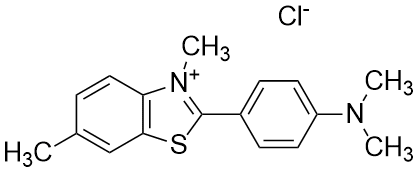Thioflavin T is widely utilized in research focused on:
- Protein Aggregation Studies: It is commonly used as a fluorescent dye to detect amyloid fibrils in various neurodegenerative diseases, helping researchers understand conditions like Alzheimer's.
- Cellular Imaging: This compound is employed in live-cell imaging to visualize cellular structures and processes, providing insights into cell behavior and function.
- Drug Discovery: Thioflavin T is valuable in screening potential drug candidates that target protein misfolding, aiding pharmaceutical companies in developing effective treatments.
- Environmental Monitoring: It can be used to assess the presence of certain pollutants in water samples, contributing to environmental safety and compliance.
- Biomarker Development: The compound plays a role in the identification of biomarkers for various diseases, enhancing diagnostic capabilities in clinical settings.
Informations générales
Propriétés
Sécurité et réglementation
Applications
Thioflavin T is widely utilized in research focused on:
- Protein Aggregation Studies: It is commonly used as a fluorescent dye to detect amyloid fibrils in various neurodegenerative diseases, helping researchers understand conditions like Alzheimer's.
- Cellular Imaging: This compound is employed in live-cell imaging to visualize cellular structures and processes, providing insights into cell behavior and function.
- Drug Discovery: Thioflavin T is valuable in screening potential drug candidates that target protein misfolding, aiding pharmaceutical companies in developing effective treatments.
- Environmental Monitoring: It can be used to assess the presence of certain pollutants in water samples, contributing to environmental safety and compliance.
- Biomarker Development: The compound plays a role in the identification of biomarkers for various diseases, enhancing diagnostic capabilities in clinical settings.
Documents
Fiches de données de sécurité (FDS)
La FDS fournit des informations de sécurité complètes sur la manipulation, le stockage et l’élimination du produit.
Spécifications du produit (PS)
Le PS fournit une description complète des propriétés du produit, notamment sa composition chimique, son état physique, sa pureté et les exigences de stockage. Il détaille également les plages de qualité acceptables et les applications prévues du produit.
Certificats d'analyse (COA)
Recherchez des certificats d'analyse (COA) en saisissant le numéro de lot du produit. Les numéros de lot et de lot se trouvent sur l'étiquette d'un produit, après les mots « Lot » ou « Lot de fabrication ».
Numéro de catalogue
Numéro de lot/série
Certificats d'origine (COO)
Ce certificat d'exploitation confirme le pays dans lequel le produit a été fabriqué, et détaille également les matériaux et composants utilisés et s'il est issu de sources naturelles, synthétiques ou autres sources spécifiques. Ce certificat peut être requis pour les douanes, le commerce et la conformité réglementaire.
Numéro de catalogue
Numéro de lot/série
Fiches de données de sécurité (FDS)
La FDS fournit des informations de sécurité complètes sur la manipulation, le stockage et l’élimination du produit.
DownloadSpécifications du produit (PS)
Le PS fournit une description complète des propriétés du produit, notamment sa composition chimique, son état physique, sa pureté et les exigences de stockage. Il détaille également les plages de qualité acceptables et les applications prévues du produit.
DownloadCertificats d'analyse (COA)
Recherchez des certificats d'analyse (COA) en saisissant le numéro de lot du produit. Les numéros de lot et de lot se trouvent sur l'étiquette d'un produit, après les mots « Lot » ou « Lot de fabrication ».
Numéro de catalogue
Numéro de lot/série
Certificats d'origine (COO)
Ce certificat d'exploitation confirme le pays dans lequel le produit a été fabriqué, et détaille également les matériaux et composants utilisés et s'il est issu de sources naturelles, synthétiques ou autres sources spécifiques. Ce certificat peut être requis pour les douanes, le commerce et la conformité réglementaire.

